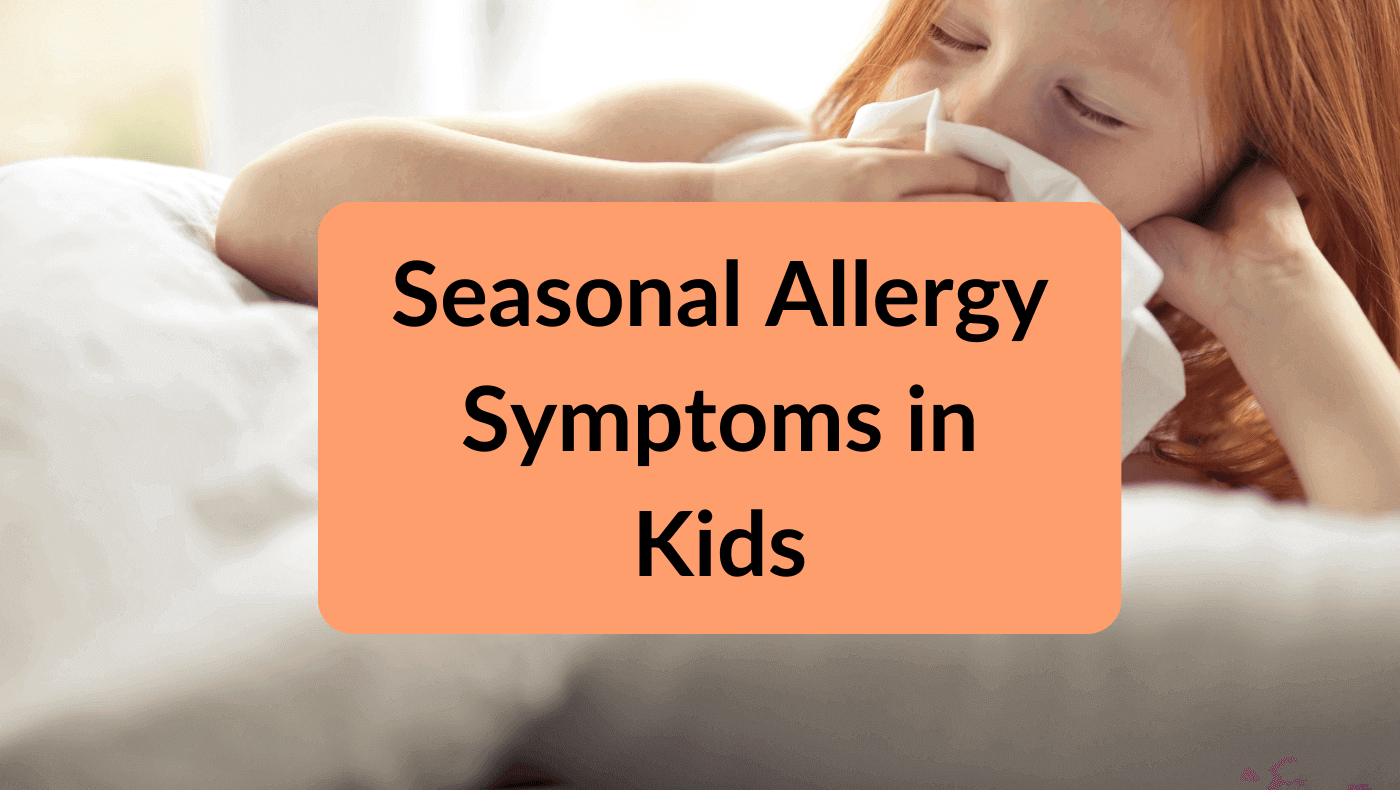Last updated on April 22nd, 2025 at 04:22 am
When the flowers bloom and the grass turns green each spring, it’s a beautiful sight—but for many kids, it’s also the start of sneezing, watery eyes, and restless nights. Seasonal allergies, sometimes known as hay fever, are common among children and can take a toll if not managed properly. This post will help you understand seasonal allergy symptoms in kids, what causes them, simple prevention tips, and effective remedies to help your child feel their best.
What Are Seasonal Allergies?
Seasonal allergies occur when the immune system overreacts to allergens such as pollen, grass, or mold spores, often found in the environment during certain times of the year.
When allergens enter the body, they can trigger symptoms as part of the immune response.
Kids may be particularly affected due to their developing immune systems, smaller nasal passages, and higher likelihood of spending time outdoors during allergy season.
Common Causes of Seasonal Allergies:
- Pollen: From trees, grasses, and weeds.
- Mold spores: Often present in damp or shaded areas.
- Grass and weeds: Especially common during the summer months.
Common Seasonal Allergy Symptoms in Kids
Recognizing seasonal allergy symptoms is the first step toward getting relief.
Here’s what to watch for in your child during allergy season:
- Sneezing
- Runny or stuffy nose
- Itchy eyes, nose, or throat
- Watery eyes
- Coughing or throat irritation
- Postnasal drip
- Dark circles under the eyes (also called “allergy shiners”)
- Trouble sleeping or feeling fatigued
- Increased irritability or moodiness
- Ear congestion or popping
How to Tell if It’s Allergies vs. a Cold:
- Allergies often persist for weeks during allergy season, while colds usually last about one week.
- Fevers and body aches are signs of a cold, not allergies.
- If symptoms occur consistently in the spring and summer, allergies are likely to blame.
When Is Allergy Season?
Allergy season can vary depending on where you live, but here’s a general breakdown by region and season:
- Spring Allergies: Pollen from trees and flowering plants makes spring a difficult time for many children.
- Summer Allergies: Grass pollen becomes dominant, along with weeds like ragweed.
- Fall Allergies: Allergens like mold spores and weeds can trigger symptoms in the autumn.
Spring is often the most challenging time of year due to the sheer volume and variety of tree and plant pollens in the air. Depending on your region, tracking pollen counts for your area online can help you prepare before the season hits.
What Are the 10 Most Common Allergies in Kids?
Allergies can stem from both indoor and outdoor sources.
Here are the most common culprits when it comes to childhood allergies:
- Pollen (trees, grasses, weeds)
- Dust mites
- Mold
- Pet dander (from cats, dogs, etc.)
- Insect stings
- Food allergens (e.g., peanuts, eggs, dairy)
- Medications
- Latex
- Fragrances or chemicals (e.g., perfumes, cleaning products)
- Cockroach droppings
Indoor vs. Outdoor Allergens
Indoor Allergens: Pet dander, dust mites, and mold.
Indoor allergens are often particularly troublesome because they are present year-round and can accumulate in enclosed spaces. Pet dander is a protein found in the skin cells, saliva, and urine of animals, and it can linger in carpets, furniture, and bedding. Dust mites, tiny creatures invisible to the naked eye, thrive in warm, humid environments and are commonly found in mattresses, pillows, and upholstered furniture. Mold, another common indoor allergen, grows in damp or poorly ventilated areas such as bathrooms, basements, and kitchens. Regular cleaning, reducing humidity levels, and using air purifiers can help mitigate exposure to these common indoor allergens, creating a healthier living environment.
Outdoor Allergens: Pollen and grass during different seasons.
Outdoor allergens, such as pollen and grass, are among the most common triggers for seasonal allergies, often referred to as hay fever. These allergens are typically more prevalent during specific seasons, with tree pollen dominating in spring, grass pollen in late spring and summer, and weed pollen in late summer and fall. Windy conditions can further spread these allergens, increasing exposure. Additionally, mold spores, which thrive in damp and decaying organic matter like leaves or soil, can also contribute to outdoor allergies, especially after rain or in humid climates. Limiting time outdoors during peak pollen hours, keeping windows closed, and showering after exposure can help manage symptoms.
How to Prevent Seasonal Allergies in Kids
While you likely can’t eliminate all allergens, consistent preventative measures can dramatically reduce the severity of your child’s symptoms.
- Use Air Purifiers: A high-quality air purifier with a HEPA filter can remove allergens from indoor air.
- Keep Windows Closed: On days with high pollen or mold counts, keep your home sealed with windows shut.
- Wash Outdoors Off: After playing outside, encourage kids to wash their hands, bathe, and change clothes.
- Bathe Before Bed: Removing allergens from skin and hair before bedtime can improve sleep quality.
- Use Allergen-Proof Bedding: Covers on pillows and mattresses can protect against dust mites.
- Stay Updated on Pollen Counts: Use an app or weather forecast to track local allergens.
How to Get Rid of Seasonal Allergies Fast
If prevention isn’t enough, here are practical and natural remedies for helping kids get relief from seasonal allergies.
Practical Remedies for Seasonal Allergy Symptoms
- Saline Nasal Rinse: Flush out allergens with a gentle saline spray or rinse, available over the counter.
- Xlear Xylitol Nasal Spray: This natural nasal spray can help rinse allergens from the nasal passages and reduce irritation. Made with xylitol, it helps moisturize and protect the nasal tissue while promoting easier breathing.
- D-Hist Jr’s: This is a natural supplement designed to support respiratory health and reduce allergy symptoms. It contains ingredients like quercetin, bromelain, and stinging nettle leaf, known for their ability to normalize immune response and alleviate seasonal discomfort.
- Genexa Kids’ Allergy Relief: Genexa Kids’ Allergy Relief is a dye-free, organic, and non-GMO option formulated to help alleviate allergy symptoms in children. With an antihistamine to reduce nasal congestion, sneezing, and itchy eyes, it provides effective relief without artificial fillers or synthetic dyes, offering a cleaner choice for your child’s allergy care.
- Homeopathic Remedy: Consider trying Boiron Histaminum Hydrochloricum as a natural option to help manage allergy symptoms. This gentle remedy is designed to support the body’s response to allergens without causing drowsiness or other common side effects.
- Pediatric Antihistamines: Speak to your doctor about kid-safe options like loratadine or cetirizine.
- Stay Hydrated: Drinking plenty of water can keep mucus thin and flowing.
Natural Remedies and Supplements for Seasonal Allergies
Managing seasonal allergies effectively often requires a combination of natural remedies and targeted supplements to alleviate symptoms and support your immune system. Below are some recommended strategies to help you through allergy season:
- Herbal Teas: Chamomile or peppermint teas are excellent for soothing irritated throats and relaxing the body, especially after exposure to allergens.
- Vitamin C & Quercetin: Found naturally in fruits like oranges, apples, and berries, these nutrients can reduce inflammation and lessen allergic responses. Quercetin can also be taken as a supplement to help control histamine release.
- Essential Oils: Diffusing oils such as eucalyptus or peppermint may help clear nasal passages and provide relief from congestion.
- Local Honey: Consuming small amounts of honey produced in your area is believed to help build a tolerance to local pollens over time.
- Probiotics: Supporting a healthy gut microbiome with probiotics can enhance immune function and may gradually reduce allergic responses.
- Stinging Nettle: With natural anti-inflammatory properties, stinging nettle is a common herbal remedy for sneezing, nasal congestion, and other allergy symptoms.
- Vitamin D: Many individuals are deficient in this essential vitamin, which plays a crucial role in immune health. Supplementing with vitamin D can boost your body’s ability to handle seasonal allergies.
- Omega-3 Fatty Acids: Known for their anti-inflammatory benefits, omega-3 supplements can help minimize allergy symptoms and support respiratory health.
Combining natural remedies with immune-supporting supplements can make a significant difference when battling seasonal allergies.
However, always consult a healthcare professional before trying new supplements, especially if you take other medications or have pre-existing health conditions. With the right balance of care, you can better manage your allergies and enjoy the changing seasons.
When to See a Doctor
Although seasonal allergies are generally manageable, there are times when medical intervention is needed.
Seek Professional Advice If:
- Symptoms persist despite home remedies and OTC medications.
- Your child’s allergies are affecting their sleep, school performance, or appetite.
- They show signs of asthma, such as wheezing or difficulty breathing.
- Severe reactions like swelling or hives occur.
An allergist can conduct tests to identify specific triggers and develop a plan to manage them better.
Addressing Gut and Immune System Dysfunctions
Research suggests that the gut and immune system play a vital role in managing allergies. A healthy gut microbiome aids in regulating immune responses and may help reduce allergic reactions.
To address gut and immune system dysfunctions, consider incorporating probiotics and prebiotics into your child’s diet to support gut health. Foods rich in fiber, such as fruits, vegetables, and whole grains, can also promote a balanced microbiome.
Additionally, reducing processed foods and added sugars may help alleviate systemic inflammation, which can contribute to allergies. Consulting a healthcare professional or nutritionist can provide personalized recommendations tailored to your child’s specific needs, ultimately helping to manage and potentially reduce allergy symptoms.
Take Control of Allergy Season Now
Don’t wait until allergies have your little one down. By staying proactive with preventative measures, natural remedies, and medical guidance when needed, you can help your child enjoy the season to the fullest.
Looking for more ways to tackle seasonal allergies? Keep track of the seasonal allergy symptoms and stay prepared with our helpful tips.
If you found this guide useful, leave a comment below and subscribe for more advice to keep your family happy and healthy. Share this post with a friend who might need it this spring!
Additional Resource:
- Autism Detox: Natural Detox Options for Kids
- Understanding Autism and Food Allergies Symptoms, Types, and Home Remedies
- Picky Eating and Autism Spectrum





0 Comments